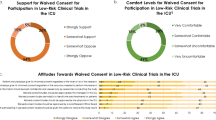Abstract
Objective:To evaluate whether informed consent was obtained prior to transfers of patients from a community hospital to a Veterans Affairs medical center.
Design:Cross-sectional study.
Setting:A Department of Veterans Affairs medical center.
Participants:Eighty-six consecutive interhospital-transferred patients. Nearly all were white men, with a median age of 62.5 years. Fifty percent had three or more active medical problems and 17% had been transferred from intensive care units.
Measurements and main results:The authors defined informed consent as a discussion of benefits, risks, and alternatives to transfer. Following transfer, patients and physicians were interviewed using standardized parallel questionnaires. Physician-patient communication regarding the benefits and risks of transfer was infrequent. Informed consent was reported for none of the transfers by patient interview, compared with 11% of the transfers assessed by physician interview. Risks of transfer were discussed infrequently according to both physicians (17%) and patients (13%). Physicians perceived a risk to the patient in 21% of patient transfers, and in 36% of transfers defined by objective criteria as high-risk. Physicians recalled discussing benefits of transfer more frequently than did patients (80% vs. 42%, t test, p<0.001). Physicians also recalled discussing alternatives to transfer more frequently than did patients (61% vs. 18%, t test p<0.001).
Conclusions:Verbal informed consent is obtained infrequently prior to interhospital transfer of patients. Risks of transfer are seldom perceived and discussed with patients.
Similar content being viewed by others
References
Schiff RL, Ansell DA, Schlosser JE, Idris AH, Morrison A, Whitman S. Transfers to public hospital: a prospective study of 467 patients. N Engl J Med. 1986;314:552–7.
Kellermann AL, Hackman BB. Emergency department patient ‘dumping’: an analysis of interhospital transfers to the Regional Medical Center at Memphis, Tennessee. Am J Public Health. 1988;78:1287–92.
Kerr HD, Byrd JC. Community hospital transfers to a VA medical center. JAMA. 1989;262:70–3.
Olson CM, Jastremski MS, Vilogi JP, Madden CM, Beney KM. Stabilization of patients prior to interhospital transfer. Am J Emerg Med. 1987;5:33–9.
Devise P. Cook County Hospital: bulwark of Chicago’s apartheid health system. New Physician. 1971;20:394–8.
Frew SA, Roush WR, LaGreca K. COBRA: implications for emergency medicine. Ann Emerg Med. 1988;17:835–7.
Hudson T. New patient transfer amendments pose problems for hospitals. Hospitals. 1990;64:46–9.
Anonymous. New patient transfer laws take effect. ACEP News. 1990;9:13–9.
Anderson RJ, Cawley KA, Andrulis DP. The evolution of a public hospital transfer policy. Metropolitan Hospital. Chicago: American Hospital Association, 1985;2(1).
American College of Emergency Physicians. Guidelines for transfer of patients. Ann Emerg Med. 1985;14:1221–2.
Pfeiffer E. A short portable mental status questionnaire for the assessment of organic brain deficit in elderly patients. J Am Geriatr Soc. 1975;23:433–41.
Bion JF, Edlin SA, Ramsay G, McCabe S, Ledingham IM. Validation of a prognostic score in critically ill patients undergoing transport. Br Med J. 1985;291:432–4.
Kellermann AL, Ackerman TF. Interhospital patient transfer: the case for informed consent. N Engl J Med. 1988;319:643–6.
President’s Commission for the Study of Ethical Problems in Medicine and Biomedical and Behavioral Research. Washington, DC: Government Printing Office, 1982;3:193–251.
Lidz CW, Meisel A, Osterweis M, Holden JL, Marx JH, Munetz MR. Barriers to informed consent. Ann Intern Med. 1983;99:539–43.
Author information
Authors and Affiliations
Additional information
Received from the Division of General Internal Medicine, Clement J. Zablocki Veterans Affairs Medical Center and the Medical College of Wisconsin, Milwaukee, Wisconsin.
Rights and permissions
About this article
Cite this article
Jablonski, D.F., Mosley, G.M., Byrd, J.C. et al. Informed consent for patient transfers to a veterans affairs medical center. J Gen Intern Med 6, 229–232 (1991). https://doi.org/10.1007/BF02598965
Issue Date:
DOI: https://doi.org/10.1007/BF02598965




